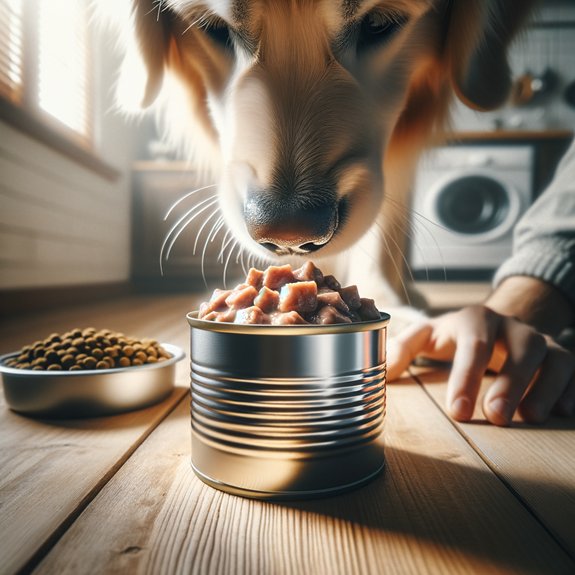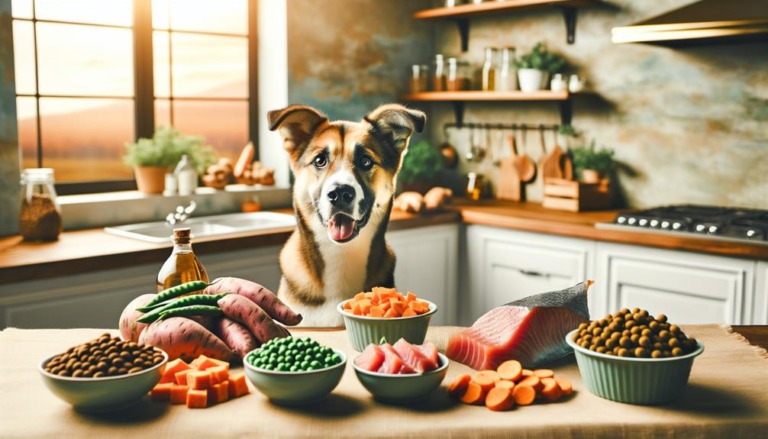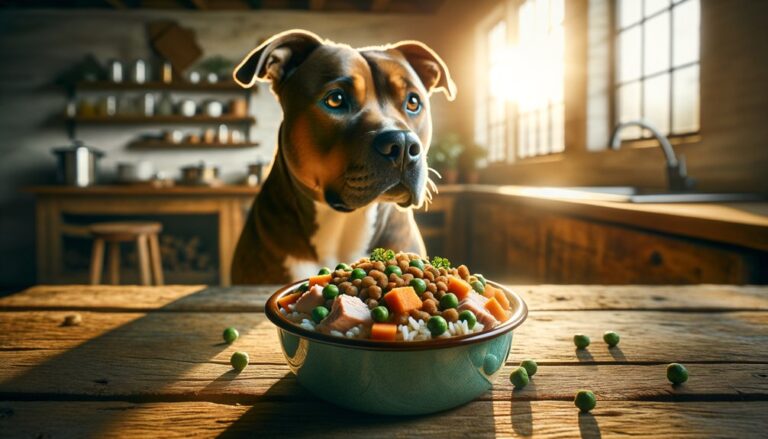The Best Fluffy Pancakes recipe you will fall in love with. Full of tips and tricks to help you make the best pancakes.

Keeping your dog hydrated, satisfied, and healthier may be easier with canned food — discover the key benefits that could change your pet’s wellbeing. You might think canned food is just pricier kibble — but its higher moisture content can meaningfully improve hydration, urinary dilution, and renal workload in at-risk dogs. If your pet eats poorly, is older, or has digestive or urinary concerns, canned diets offer greater palatability, pre-softened proteins, and more controlled nutrient delivery. Keep going to see practical transition steps, monitoring points, and when a therapeutic wet diet may be warranted.
Key Takeaways
- Higher moisture in canned food improves hydration, dilutes urine, and can lower risk of kidney or certain urinary issues.
- Enhanced aroma and texture of canned food increases palatability, helping picky, elderly, or unwell dogs eat more reliably.
- Canned diets offer controlled nutrient profiles and therapeutic formulations for renal, urinary, or gastrointestinal management.
- Lower calorie density
- Canned food’s homogeneous processing and limited-ingredient options simplify dietary trials and reduce antigen exposure.

Benefits of Increased Moisture and Hydration in Dog Food
Q: Why does moisture in dog food matter? A: Adding moisture to your dog’s meals is more than a small detail—it’s a proven, evidence-based way to support overall health. A hydration-focused feeding approach for dogs with kidney issues, urinary stone prevention, digestion support, or reduced thirst can make a measurable difference in long-term wellness.
Key Benefits for Pet Owners
- Increased water intake in dogs: Hydrated dog food ensures your pet consumes more water naturally, without relying on voluntary drinking.
- Reduced kidney stress and lower renal solute load: Especially important for dogs prone to kidney stones or chronic kidney disease.
- Consistent urine concentration and lower urine specific gravity: Clinical studies confirm that moist dog food reduces risk factors for urinary stone formation.
- Better thermoregulation in dogs: Hydration helps maintain stable body temperature, supporting both active and senior pets.
- Healthier oral and gastrointestinal mucosa: Moisture supports mucosal integrity, reducing irritation and aiding digestion.
- Best moist dog food for kidney support in senior pets: Ideal for older dogs or those with mobility limitations who may not drink enough water.
- Hydrated dog food for digestion support: Improves nutrient absorption and reduces gastrointestinal stress.
- Moist dog food for urinary stone prevention in older pets: Helps minimize risks in senior dogs with reduced thirst or limited mobility.
- Hydrated dog food for weight management: Supports healthy body weight
- Hydration-focused feeding approach for urinary health: Supports long-term renal function and reduces chronic kidney stress.
Monitoring Results at Home
Q: How can I track the benefits of hydrated dog food? A: Monitor:
- Body weight changes
- Urine output and consistency
- Laboratory markers (BUN, creatinine, urine specific gravity)
This data helps you and your veterinarian evaluate the impact of a hydration-focused feeding plan.
Balanced Nutrition and Hydration
Q: Does moisture replace balanced nutrition? A: No. Hydration is a complementary strategy that enhances balanced nutrition. It aligns you with a community of dog owners who prioritize measurable health outcomes, long-term kidney support, weight management, and systemic wellness.
Improved Palatability for Picky or Senior Dogs
Beyond hydration, canned diets routinely provide sensory cues—enhanced aroma, texture and fat dispersion—that increase voluntary intake in dogs with reduced appetite. You’ll observe that these sensory characteristics objectively enhance picky eater appeal: stronger olfactory signals and moist, cohesive textures trigger feeding behaviors that dry kibbles often don’t. Clinical studies report increased meal acceptance and shorter latency to eat in dogs transitioned to canned formulations, particularly among aging cohorts.
When you care for a senior pet, senior dog palatability becomes critical for maintaining energy balance and medication compliance. You can use canned food to offer consistent, measurable improvements in acceptance without forcing feeding. Monitor intake, body condition, and any changes in stool quality; adjust portions to maintain weight goals. In group settings or multi-dog households, choose formulations with proven palatability profiles to reduce competition and stress. These evidence-based steps help you sustain nutritional intake while preserving the social bond between you and your dog.
Digestibility and Nutrient Absorption Advantages
When you switch to canned food, proteins are often pre-softened hydrolysis, so your dog can break them down with less metabolic effort. The high moisture content also facilitates gastrointestinal transit and can improve mucosal hydration, which supports nutrient absorption. Clinical studies show these factors can increase bioavailability of amino acids and electrolytes compared with many dry diets.
Easier Protein Breakdown
Curious about why canned food often improves protein use? You’ll find that canned formulations typically present proteins in a denatured but digestible state due to heat and moisture processing, which facilitates enzymatic action in the canine gut. This enhanced protein breakdown increases amino acid availability per meal, and studies report higher ileal digestibility coefficients for wet diets compared with many dry kibbles.
When you choose canned food, you’re selecting a matrix that reduces anti-nutritional factors and may require less gastric work to liberate peptides. That doesn’t mean every dog needs it, but for animals with marginal digestion or higher amino acid needs, canned diets can deliver measurable improvements in absorbed protein.
You’re part of a community aiming for evidence-based nutrition choices.
Improved Hydration Absorption
How does canned food affect your dog’s hydration and nutrient uptake? Canned diets provide measurable hydration synergy: higher moisture content improves gastric solubilization and promotes enzymatic access to nutrients, so your dog absorbs proteins, fats, and micronutrients more efficiently. You’ll notice clinical benefits without guesswork.
- Enhanced gastric fluid balance: moisture impact increases chyme fluidity, aiding nutrient diffusion.
- Faster enzyme-substrate interaction: improved solubilization raises digestibility coefficients.
- Reduced renal load: better hydration supports renal clearance and electrolyte stability.
- Supportive for group care: shared routines with canned diets foster consistency and inclusion.
These statements reflect controlled nutritional physiology findings. You and your community can expect predictable improvements in nutrient uptake when choosing canned food with demonstrated moisture impact.
Role in Weight Management and Portion Control
When you compare canned and dry diets, you’ll note canned food typically has lower calorie density
You’ll find portion measurement is more straightforward with volumetric or gram-based servings for canned food, allowing tighter control of daily calories.
Controlled portions of higher-moisture, more satiating canned meals can improve satiety and support scheduled meal timing for weight management.
Calorie Density Differences
Why does calorie density matter when you switch a dog from dry to canned food? You’ll notice canned diets often have lower calorie density and reduced energy concentration per gram, which affects daily intake and weight outcomes. Use evidence-based awareness to adjust feeding decisions while staying connected to a caring community of pet owners.
- Lower energy concentration in canned food can help prevent inadvertent overfeeding.
- You’ll need to account for moisture content when comparing kcal per cup vs kcal per can.
- Studies show satiety signals differ with energy density, influencing meal frequency and body condition.
- Monitor body weight and adjust kcal intake collaboratively with your veterinarian to maintain ideal condition.
This clinical approach helps you manage weight precisely and inclusively.
Portion Measurement Ease
Many pet owners find canned food simplifies portion measurement because its uniform texture and labeled can sizes let you deliver consistent gram- or kcal-based servings with less variability than scooping dry kibble.
You can follow feeding guidelines more reliably when each can corresponds to a reproducible weight; manufacturers often state kcal per can, enabling precise daily rationing.
This consistency reduces measurement error, supports objective monitoring of intake, and helps you detect deviations from target weight trajectories sooner.
Use a calibrated kitchen scale and document portions to maintain adherence to clinical recommendations.
For multi-dog households, labeled cans make individualized portioning straightforward and equitable.
Satiety and Meal Timing
Although canned food typically contains more moisture and protein gastric volume and postprandial fullness, so feeding it can help you reduce total caloric intake without leaving the dog hungry. You’ll observe clearer satiety cues and can adjust meal pacing to reinforce portion control. Consistent timing and portion consistency support weight management and behavioral predictability, which builds your confidence and sense of community with other conscientious owners.
- Use measured portions based on caloric density and body condition scoring.
- Monitor satiety cues (slower eating, relaxed posture) and record responses.
- Implement controlled meal pacing (smaller, timed servings) to limit overeating.
- Reassess weight and adjust calories every 2–4 weeks with your veterinarian.
This approach is evidence-based, practical, and collaborative.
Urinary Tract and Kidney Health Considerations
How does diet affect your dog’s urinary tract and kidneys? You influence urinary tract function and kidney health through moisture intake, electrolyte balance, and dietary solute load.
Canned diets typically provide higher moisture, which dilutes urine, lowers concentration of lithogenic minerals, and reduces risk factors for cystitis and some uroliths.
Controlled protein and phosphorus content matter for dogs with chronic kidney disease; lower dietary phosphorus slows progression, and moderated protein reduces azotemia without causing malnutrition.
Electrolyte composition (sodium, potassium) affects hydration and renal handling of fluids.
If your dog has existing urinary or renal disease, evidence supports individualized diet formulation and monitoring of bloodwork, urine specific gravity, and urine culture.
Collaborate with your veterinarian to select a diet that targets urine dilution, appropriate phosphorus and protein levels, and electrolyte balance.
You’re part of a care team; your observations and adherence to recommended feeding and recheck schedules improve outcomes for urinary tract and kidney health.
How Canned Food Supports Therapeutic and Limited-Ingredient Diets
Building on urinary and renal considerations, canned food often offers a practical platform for therapeutic and limited-ingredient formulations because its high moisture content, controlled nutrient profiles, and homogeneous processing make precise nutrient delivery and palatability easier to achieve. You’ll find canned diets allow clinicians and caregivers to target hydration, sodium, protein, and mineral levels consistently, which supports evidence-based management of specific conditions.
Texture control and therapeutic textures improve intake in dogs with dental or dysphagic issues, while single-protein and limited ingredients formats reduce antigen exposure and simplify elimination trials.
Therapeutic textures boost intake for dogs with dental or swallowing issues, while single-protein formulas simplify elimination trials.
- Consistent nutrient matrix aids adherence to prescribed therapeutic plans.
- Moisture-rich formulations support renal and urinary management strategies.
- Homogeneous processing enables reproducible therapeutic textures for feeding tolerance.
- Limited ingredients reduce confounders during dietary trials and foster community confidence.
You’ll appreciate that canned options can be formulated to meet AAFCO and veterinary therapeutic standards, helping you and your pet feel supported in clinical dietary transitions.
Practical Costs, Storage, and Transition Tips
Want to know what switching to canned food will mean for your budget and daily routine? You’ll see higher per-calorie costs but often fewer additives, and you’ll want to plan purchases to match your dog’s feeding needs. Canned products offer storage flexibility once opened (refrigerate, use within 2–3 days) while unopened cans retain shelf stability for months to years. Transition gradually over 7–10 days to reduce gastrointestinal upset: start with 25% canned, 75% dry, increasing by 25% every 2–3 days while monitoring stool and appetite.
Cost per kcal
- Compare kcal/ounce or kcal/100g on labels to find the most economical option
Packaging waste
- Choose recyclable packaging whenever possible
- Recycle cans where accepted
Open-can storage
- Store in the refrigerator
- Cover properly
- Use within 48–72 hours
Unopened shelf life
- Check expiration dates
- Rotate stock to avoid expired products
Transition pace
- Transition gradually over 7–10 days
- Adjust based on your pet’s response
You’re part of a community seeking evidence-based choices; track outcomes and consult your veterinarian for individualized guidance.
Conclusion
Think of switching to canned food like offering your dog a shaded stream instead of a dry trail: the higher moisture gently cools, dilutes urine, and sustains intake; the softer texture and aroma prompt eating in seniors and picky dogs; nutrients are pre-softened for absorption and therapeutic control. Transition slowly, monitor weight and stool, and store properly — the clinical benefits are measurable, practical, and often decisive for hydration, renal, and digestive health.









